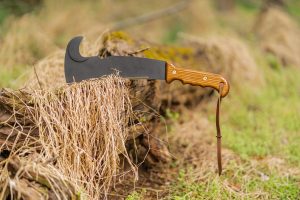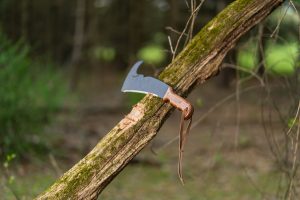Cutting Vegetation
Cutting vegetation is one of the most common things you can use a machete or knife for, and while both are viable options, the machete is going to be the best choice when it comes to most plant clearing scenarios.Machete
While machetes were initially used as a multi-tool for daily tasks, if seen today, they will more often than not be used as a way to clear some kind of vegetation. Machetes excel at clearing plants and can take on anything from grassy growth to woody saplings and brush with ease.
One of the best machete styles for cutting vegetation is the billhook with a hooked tip to allow the wielder to cut off growth at the base with ease.
of vegetation. Machetes excel at clearing plants and can take on anything from grassy growth to woody saplings and brush with ease.
One of the best machete styles for cutting vegetation is the billhook with a hooked tip to allow the wielder to cut off growth at the base with ease.
Knife
While some knives may be large enough to dispatch plant growth effectively, they are generally too small to have the same effectiveness as the machete. This same fault of being too small is also one of the knife's greatest strengths. A knife is the better choice for precision cutting and removing small growth close to the ground as you would in weeding a flower bed. A knife is also the best choice in some agricultural applications. An example of a time like this would be when you find yourself harvesting tall plants in tight rows.Harvesting Wildlife
Skinning game is an essential job for hunters and outdoor enthusiasts, and if you have ever done it before, then you know how important it is that you have a tool sharp and robust enough for the job. Two things are necessary for a practical skinning knife - a sharp blade and a point at the end. The need for a point makes a knife the best choice in this scenario, but some machetes can still get the job done.Machete
When looking at the design path of modern-day machetes, you can see them becoming increasingly plant-focused in their intended use. Several things can account for this, but the apparent reasoning, especially in America, is that a tiny percentage of people harvest their meat anymore. Even most hunters opt to take their game to a processor who is more than likely to use specialized industrial tools for the job.
Some machetes can still be used to skin game, and the argument could even be made that all machetes can be used to do it if you've got the time and patience required. But using most machetes to skin an animal is like trying to fit a square peg into a circle hole. The ideal machete for skinning an animal is the Bowie machete - it has the plant clearing ability of a machete, but it comes with a tip modeled after the Bowie knife making it perfect for harvesting your kill.
things can account for this, but the apparent reasoning, especially in America, is that a tiny percentage of people harvest their meat anymore. Even most hunters opt to take their game to a processor who is more than likely to use specialized industrial tools for the job.
Some machetes can still be used to skin game, and the argument could even be made that all machetes can be used to do it if you've got the time and patience required. But using most machetes to skin an animal is like trying to fit a square peg into a circle hole. The ideal machete for skinning an animal is the Bowie machete - it has the plant clearing ability of a machete, but it comes with a tip modeled after the Bowie knife making it perfect for harvesting your kill.